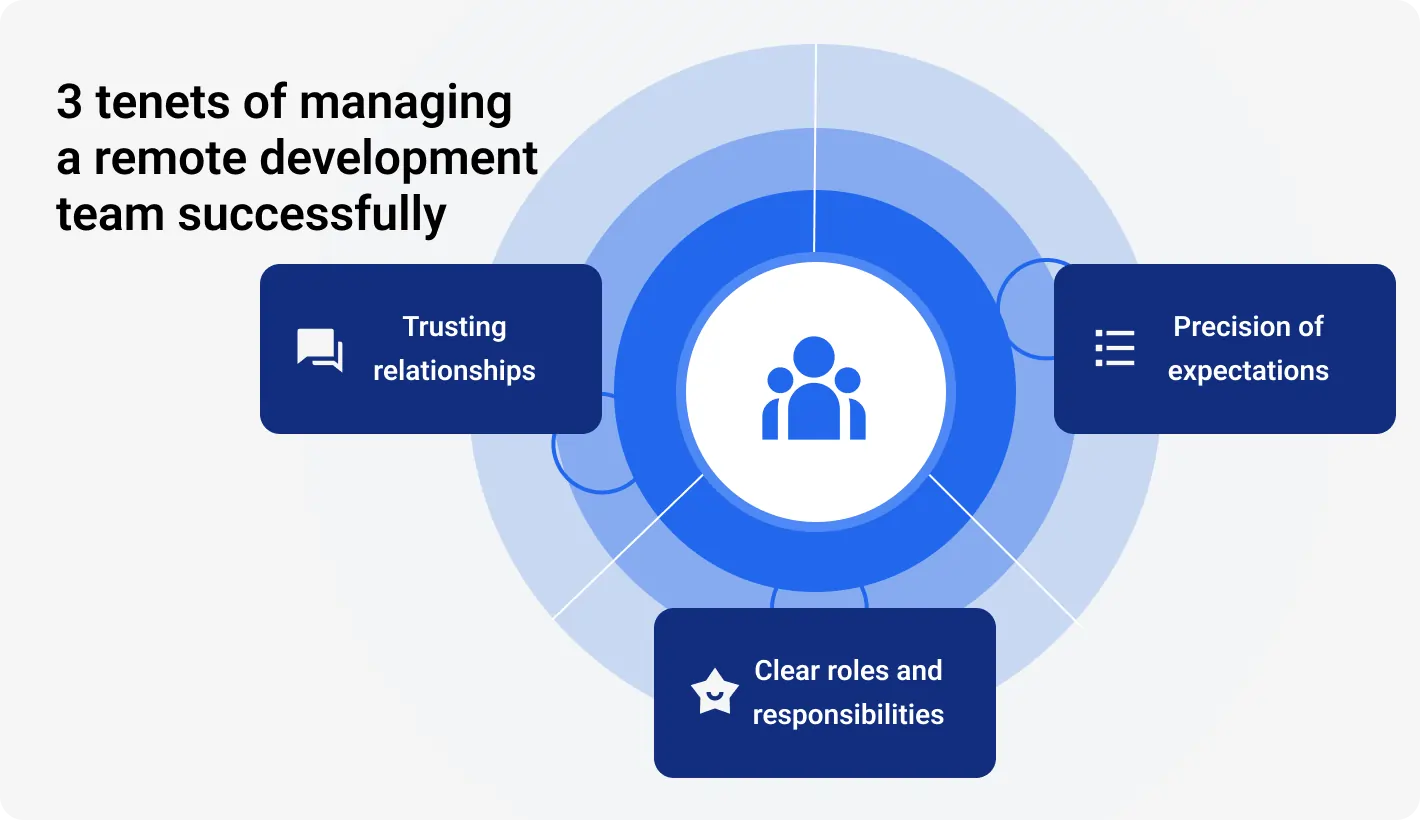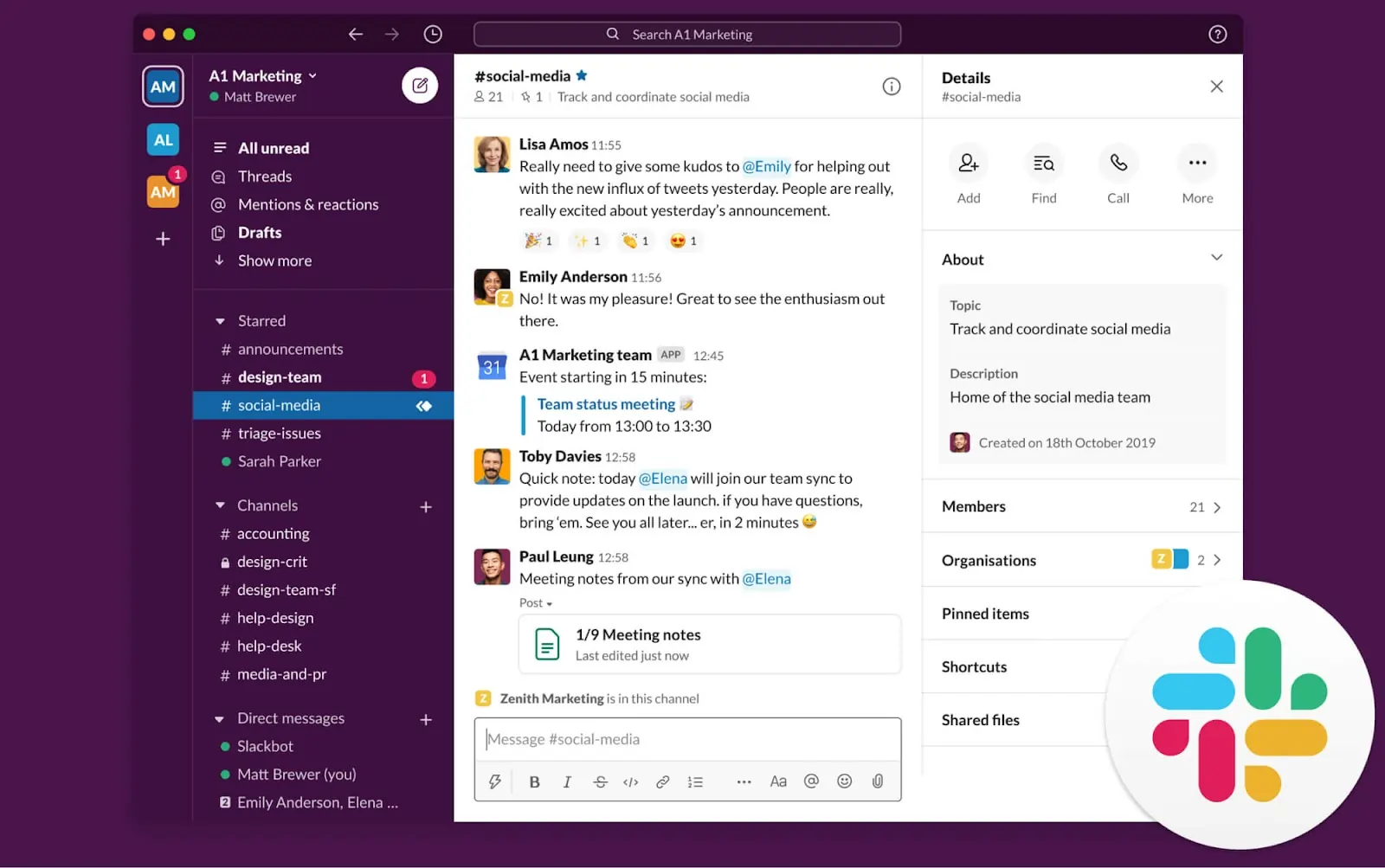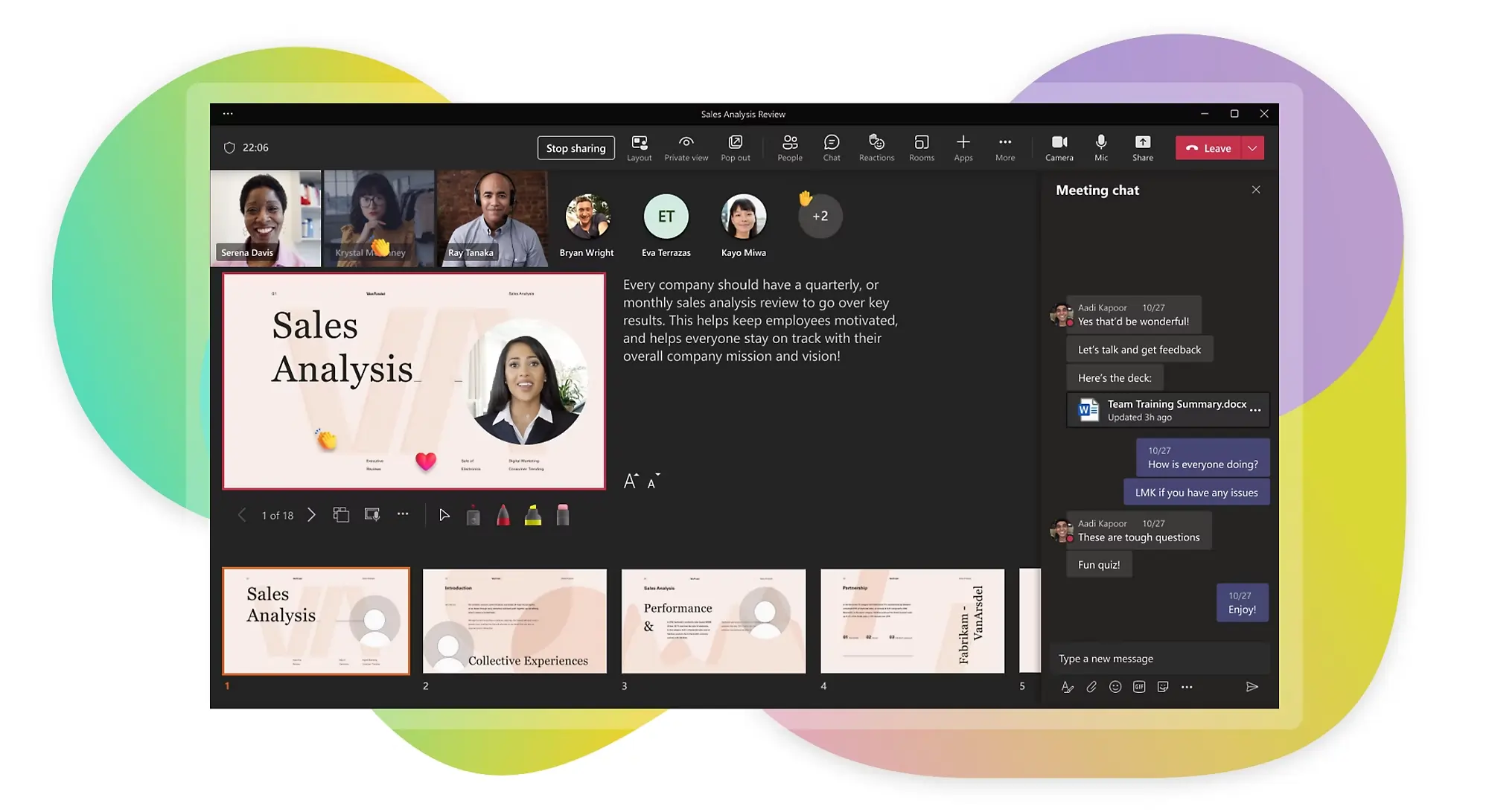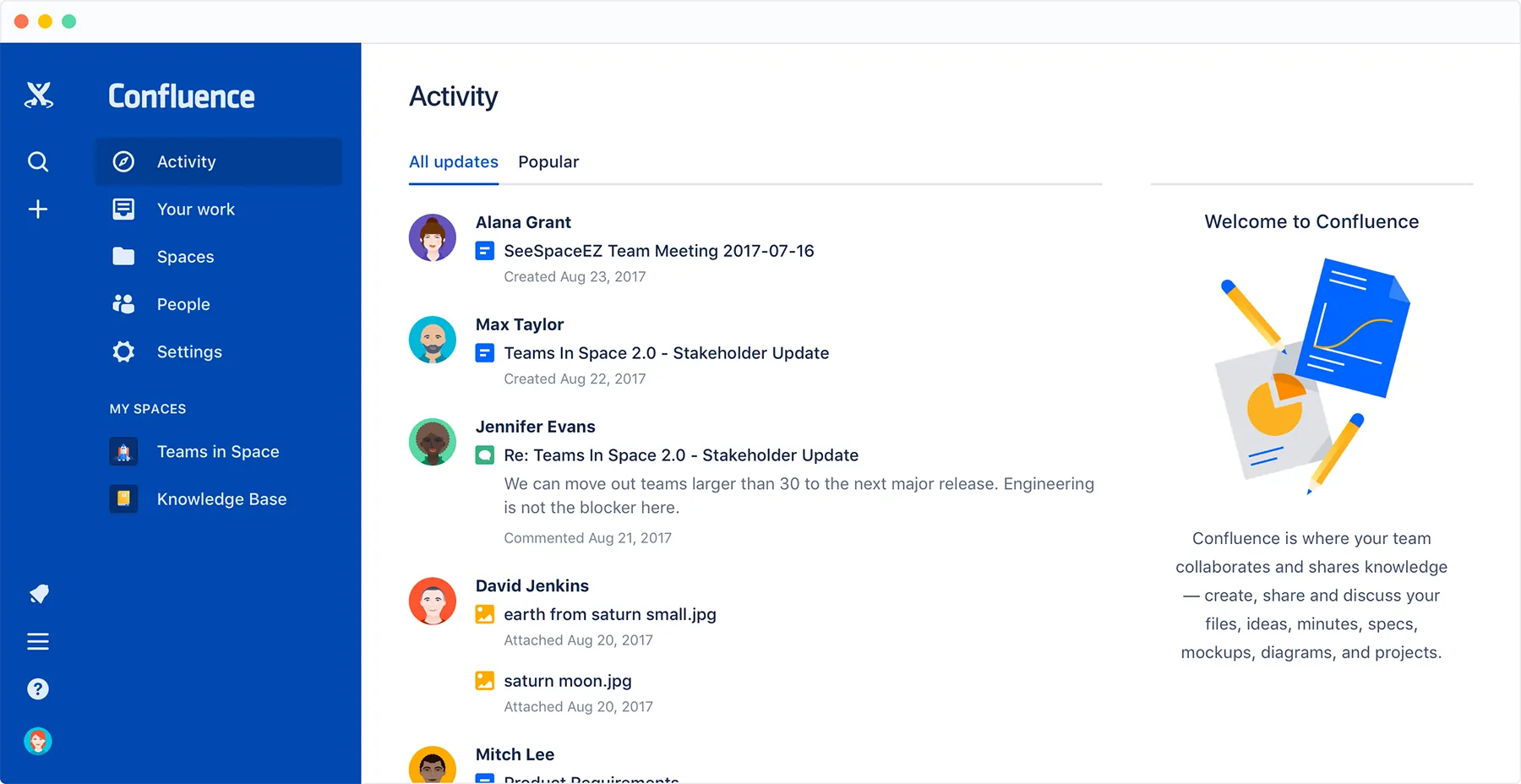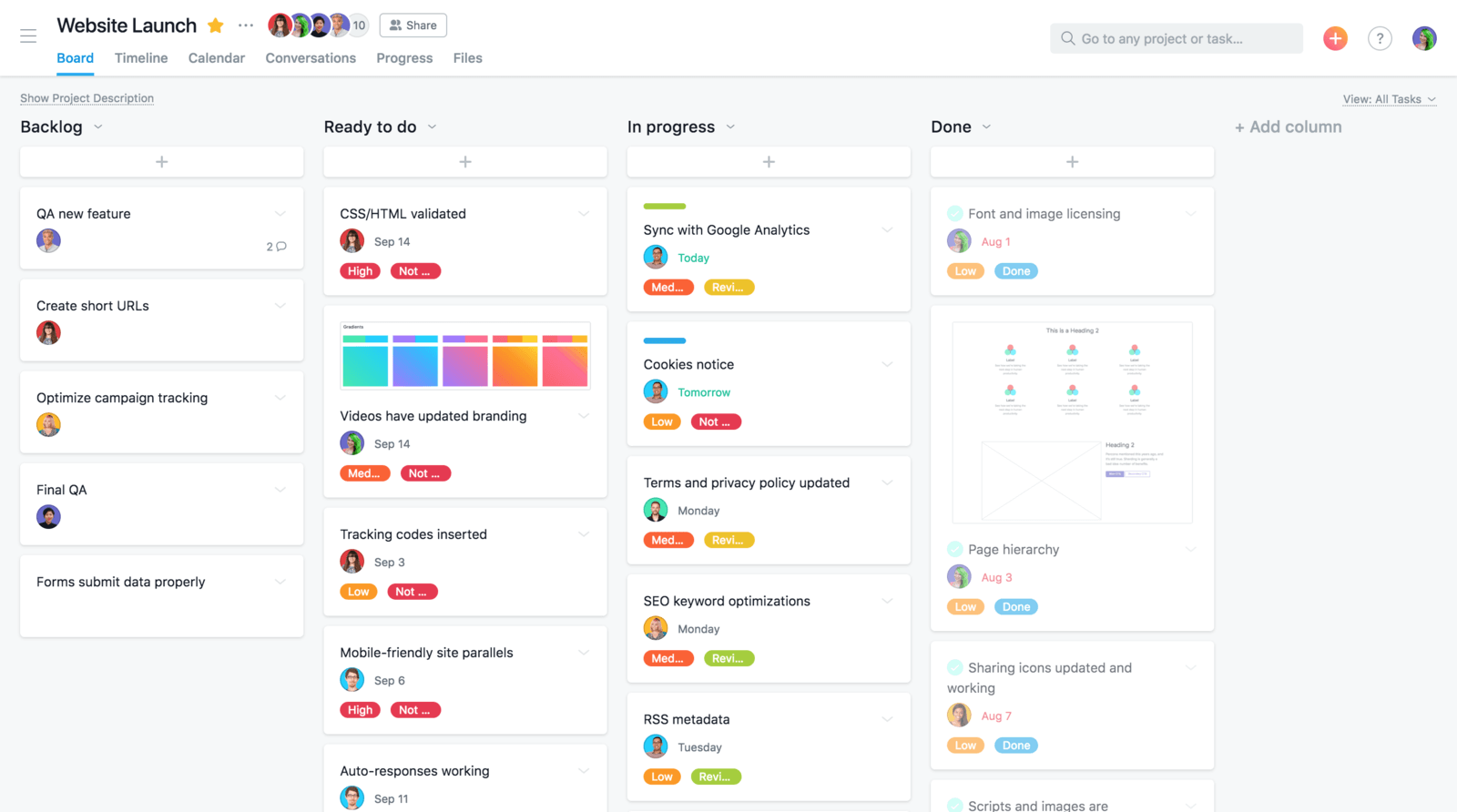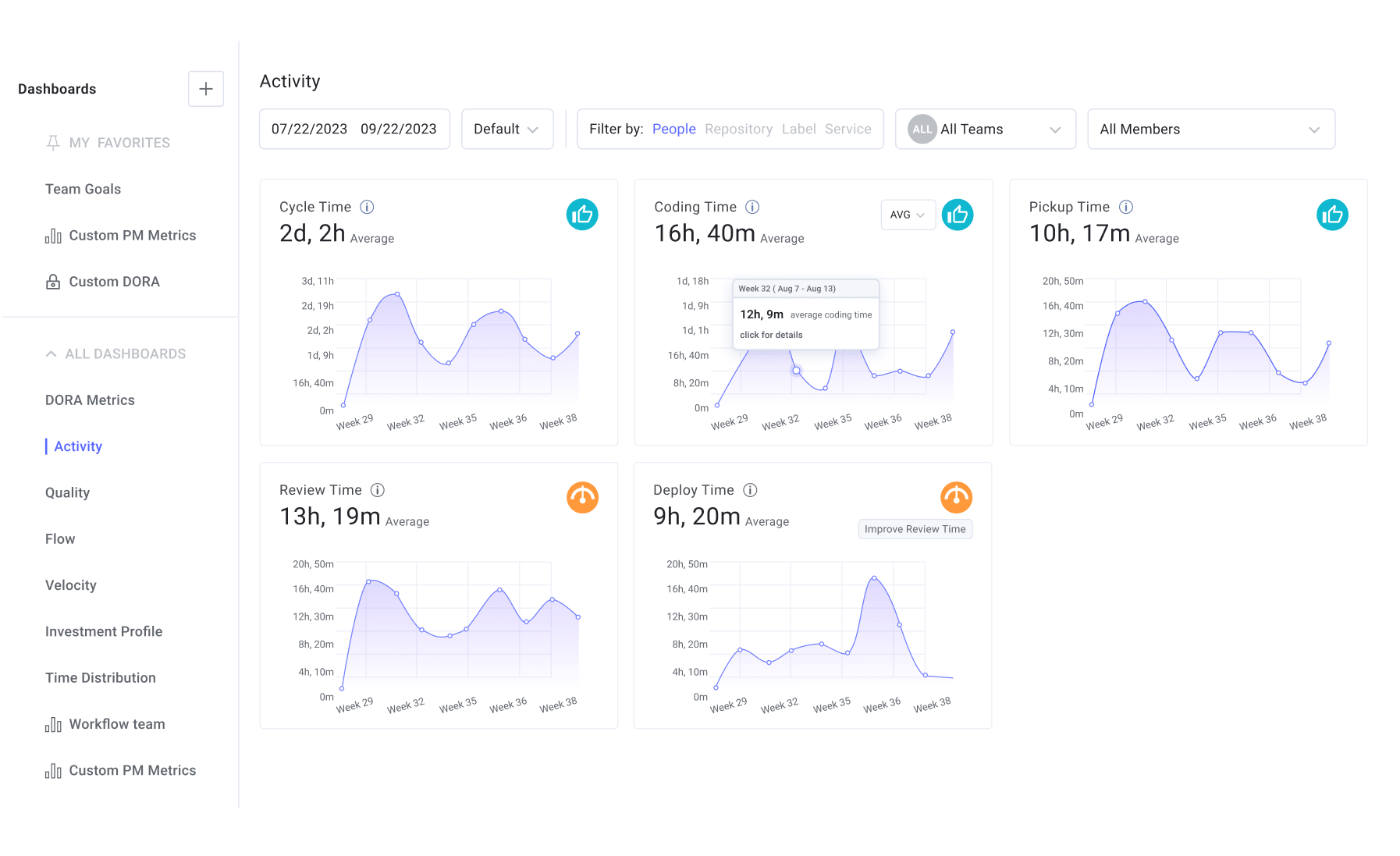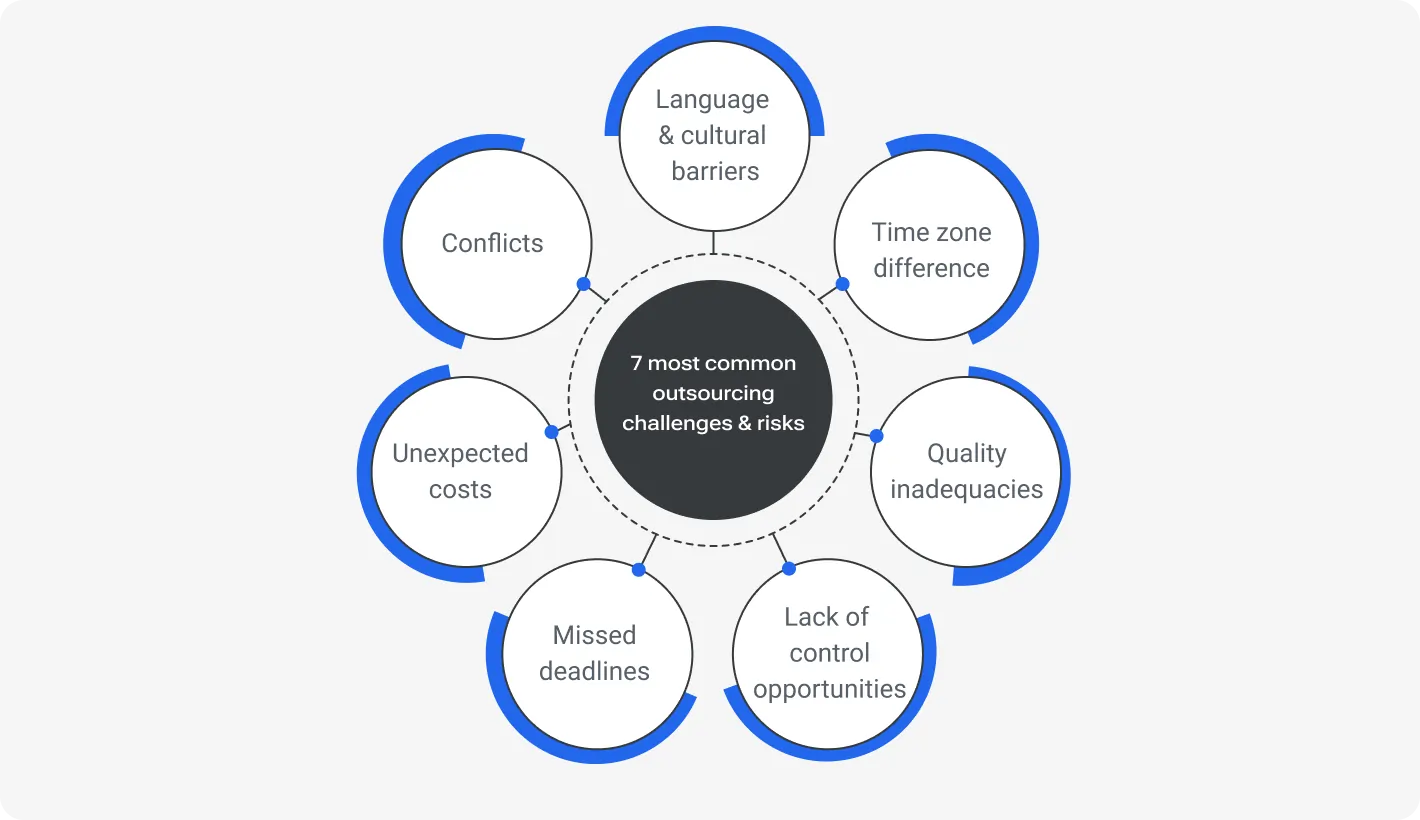Outsourcing is an extremely popular model of working, with 92% of G2000 companies and 37% of small businesses choosing it. However, recent studies show that from 30% to 50% of outsourcing relationships fail, with 20% of them being terminated in the first year after starting. The most common reasons for this are:
not meeting the customer's expectations;
To avoid these problems and make your collaboration with an outsourcing partner lasting and fruitful, you need to know the right techniques and methods for managing an outsourced development team. In this article, you will find out what tools and techniques to use to communicate and cooperate with an IT service provider effectively.
End-to-end solutions with predictable budgets, a time-to-market advantage with budget savings of up to 50%
Managing a remote development team in outsourcing: Best practices
A customer can effectively interact with a team even if it is located hundreds of kilometers away. However, you need to adhere to the three main tenets of successful collaboration. They will be discussed below.
Precision of expectations
The final result of cooperation directly depends on how clearly you describe your requirements and wishes to the executors of the work. So, make sure to complete the following points:
Formulate your objectives in the form of tasks to be accomplished.
Decide on the scope of tasks to be ordered.
Provide detailed specifications for the product you want IT specialists to develop.
Describe your code quality standards if there are any.
Specify the criteria for evaluating the work quality and assessing performance.
Document all information.
Sign a detailed and well-thought-out contract.
By following these steps, you can ensure that partners have no gaps in their understanding of what you expect from working with them. Moreover, writing everything down in an agreement ensures that your requirements will be met in good faith or that agreed compensation will be provided in the event of failure.
Clear roles and responsibilities
For each team member to understand their role in the overall outcome, areas of responsibility must be distinctly distributed. Describe which tasks each specialist is to perform, so that it is easier to monitor the workflow and assess its results.
If you have an in-house team, you need to make sure that your internal employees and external specialists are on the same page. To do this, ensure comfortable communication and a smooth flow of information between them. Also, to avoid misunderstandings and conflicts, clearly assign the roles: which tasks are the responsibility of internal employees and which tasks are the duty of external professionals.
A good example of an effective in-house and remote team collaboration with clearly defined roles can be seen in the cooperation of the Devico outsourcing company with the Tipalti fintech business. Their internal team is responsible for product development, while external specialists are in charge of quality assurance. Clear role distribution and effective communication have allowed the companies to collaborate successfully since 2011.
Trusting relationships
A culture of mutual trust and respect is very important for successful collaboration. Therefore, be open and honest when communicating with your partners and encourage the same behavior on their part. To maintain a climate of trust in your relationship, do the following:
Do not hide important information.
Always try to keep your promises;
Supervise the work, but avoid micromanagement that can be perceived as distrust;
Resolve conflicts timely;
Stay away from the culture of blaming someone particular for failures, so that the specialists are not afraid of admitting and addressing their mistakes;
Respect the culture of the country your remote team is from;
Avoid discrimination on the basis of age, gender, race, religion, and other grounds.
By following these simple steps, you will ensure comfort and ease of communication with your outsourcing partners. This will make your relationship strong and your cooperation long-term and productive.
Practical tips on communication with outsourced teams
Communication issues rank as the second most common challenge of cooperating with external IT specialists. Below you will find recommendations on how to avoid such difficulties.
Choose convenient communication channels
To avoid miscommunications and the flaws in work related to them, make your communication comfortable and uninterrupted. To stay on the same page at all times, use chats in work messengers like Slack.
This can be much more convenient than using email, which can be too slow due to infrequent inbox checking. It can also be prioritized over using personal messengers, such as WhatsApp, for work, which can disrupt work-life balance and impact productivity negatively.
Slack, a convenient messenger for work
Moreover, it is important to communicate not only in writing but also orally: with audio or video calls. For this, you can use such applications as Microsoft Teams or Google Meet.
Microsoft Teams, a great tool for holding video conferences
Share updates regularly
The exchange of relevant information is helpful for both parties. To track progress, you need to be always aware of what work has been already done. In turn, your partners have to know about:
changes in your business functioning;
modifications in your goals;
the level of satisfaction with previous tasks completed.
To ensure ongoing data sharing and effective performance monitoring, encourage regular meetings and reports. It is better to discuss their schedule in advance: at the contract signing stage.
It is useful to give detailed feedback after each report. This will help your partners to improve their work and adjust it to your wishes as precisely as possible.
Cherish the culture of trust and collaboration
Become not just partners but a united close-knit team with external IT specialists. Develop trusting relationships for successful long-term cooperation. For this, use the following techniques:
Communicate honestly and openly without reticence.
Encourage mutual feedback.
Avoid accusations and excessive negativity in feedback, but rather emphasize what and how it is possible to improve.
Appreciate each team member's contribution to the overall result.
Celebrate success together to uplift morale.
All of this will help each member of the external team feel that they are important to you and will motivate them to perform even better.
Methods and tools for effective outsourcing management
Do you want to make the work maximally productive and monitor progress as effectively as possible? For this, use the specialized techniques and tools described below in this article.
Sharing knowledge
Is your project large, consists of many elements, and has specific quality standards? Then it is crucial to ensure that everyone involved in the work process is up to date on all important information and details.
This requires a knowledge base that all team members have access to. All essential information about the project should be collected there. You can use tools like Google Drive, Confluence, Zendesk, and others to store key data and access it quickly.
Having all essential information collected in one place will allow external developers to understand your requirements as clearly as possible and deliver the results that suit your business goals best. Additionally, this knowledge base can reduce the time it takes to onboard new team members, improving your ability to scale.
Keeping documentation
Maintaining detailed documentation about the project has many benefits, for example:
Improved understanding and commonality among all project participants.
Detailed progress tracking and rigorous quality control at all stages of work.
Facilitating the adaptation of new team members.
Optimizing the task completion process with clear and detailed instructions.
Achieving a result that is as close to expectations as possible.
What documentation to maintain at different stages of work? Find out from the table below.
Essential documents for every stage of the project
Phase
Document
What it is and what information it contains
This is the cornerstone of all documentation. It describes the goals and scale of the projects, its stakeholders, and their role in it. The main question this document answers is: “Why is this project being initiated at all?”.
This document describes the means by which the primary goal specified in the charter can be achieved. This global aim is being divided into smaller objectives which are recorded in detail in SoW.
Requirements are the features and properties that the ready-made product must have. They are based on the needs of the target audience.
Specifications are technical details and quality standards of how to fulfill requirements.
This document discloses the financial side of the project. It can describe in detail the budget for each phase of the work.
Here, the deadlines for completing the whole project and its individual parts are described.
This is a list of risks the business may face and options for addressing them.
This document stores information about all modifications made to the project plan, the reasons for them, the dates they took place, and the people responsible for them.
Project status (progress) reports
These are reports about the work done and tasks completed. They allow tracking performance and progress.
The business goals may be adjusted to the market conditions. So, to modify or add something to the project plan, it is needed to make change requests.
When a certain part of the project is completed, there comes a document that summarizes the successes and failures. It allows the team to know what to improve and what to pay special attention to in their future work.
When the project is completed, the document that describes the achieved goals is drawn up. It formally finalizes the project.
Where to store documentation?
All important records should be kept in a safe and secure place. However, it should also be quickly and easily accessible to those team members who may need to find useful information in the documentation. A suitable repository for all records could be one of the specialized tools, such as Google Drive, Confluence, Document360, etc.
Confluence, a great tool for maintaining project documentation
Using project management tools
It is possible to effectively manage a team, even if its members are scattered all over the world. This can be easy thanks to convenient project management tools that give an opportunity to bring all work participants together in one place.
They also allow you to structure and systematize your workflow by keeping a record of tasks. Such tools as Asana, Jira, Trello, Basecamp, or other similar ones, can make your workflow smooth, easy to manage, and productive.
Asana, one of the convenient tools for organizing remote team collaboration and systemizing tasks
Monitoring performance
Effective progress monitoring at all stages of work is an integral part of successful collaboration. Use KPIs and analytics tools for this. Which ones and how? Find out further from this article.
KPIs in outsourced software development
In IT, many metrics can be used to measure team productivity and performance. In the table below, we have described the most essential ones.
11 most important KPIs in software development
KPI
Its definition and description
Its calculation
This is the duration of fulfilling a requirement from its initiation to its readiness for production.
The number of working hours or days it took to implement the requirement.
This is the average time for execution of a specific cycle (process): from the start to full delivery.
Calculated in the number of working hours/days.
This metric is used within agile methodologies and represents what scope of work is done on average during a sprint.
Number of story points / number of sprints (working days, hours).
It reflects the stability, efficiency, and progress of the entire work process as a whole.
It is usually represented as a visual diagram, showing the ratio of tasks to-be-done, ongoing, and ready tasks.
It shows the quality of the code. This is the ratio of changes that led to failure in production.
Number of changes that failed in production / overall number of changes * 100%
This metric is widely used in agile development methodologies and reflects the pace of work. It shows how often code is deployed to testing or production.
Number of deployments / set period of time (month, week, sprint, a certain number of working days or hours, etc.)
It helps to monitor both the quality of the code and the performance of QA engineers. It shows how many flaws were found prior to release.
The number of defects detected before release / the total number of defects (including those found after release) * 100%
This metric reflects the code stability. It shows how many times and how frequently it has been changed.
The number of modified lines of code / the total number of code lines * 100%
It represents the quality of code and its testing.
The number of code lines executed by tests / the total number of code lines * 100%
This is another indicator of code quality that shows how many flaws it contains.
The number of bugs detected / the number of tests held.
This indicator reflects the stability of the system. This is the average time it takes to regain full function after a failure.
The number of downtime hours (minutes) / the number of incidents.
By constantly monitoring these essential metrics, you can continuously monitor the team's performance and all aspects of the code quality.
Analytics tools for performance monitoring
To make it more convenient to observe the quality of work and performance, as well as changes in them over time, you can use special software. The most popular tools for tracking and keeping track of KPIs are Tableau, LinearB, Databox, Pluralsight Flow, Haystack, and others.
LinearB, a convenient tool for visualizing, tracking, and analyzing core KPIs and their dynamics
Overcoming challenges and mitigating risks
Despite all its cost-efficiency, flexibility, and other advantages, the outsourcing experience can be quite challenging. Cooperating with contractors, especially if they are hundreds of kilometers away from you geographically, carries some risks. It is important to think in advance about what dangers and problems you could potentially encounter and how you would deal with them. Below, we describe the 7 most widespread challenges and risks, as well as the ways of overcoming them.
Time zone difference
This can be both an advantage and a disadvantage. The main benefit is that if team members are in different time zones, they can work on your project in shifts 24/7 if necessary, which will allow you to gain significant time and, respectively, competitive advantage.
The most essential disadvantage, however, is that it can be a barrier to full-value communication and workflow control. The following methods can help you overcome this challenge:
Use asynchronous communication channels, such as email, written chats in work messengers, task trackers, recorded video instructions, etc. This way, your partners will be able to view important information at their convenience;
Agree on overlap hours to communicate in real-time. Even with the big difference, there should be at least a couple of hours when you both are available for work issues. Schedule calls and meetings within this period of time, so that you can have a full-value conversation without delays and discuss the most crucial and urgent topics.
Quality inadequacies
Sometimes, due to an incomplete understanding of requirements and standards, the quality of the result may not meet the customer's expectations. This can be avoided with the help of:
compiling and maintaining a knowledge base;
keeping detailed documentation;
regular communication, including video conferences;
requesting reports and providing detailed feedback on them;
conducting reviews and audits;
addressing issues early on.
Lack of control opportunities
Some businesses find effective outsourcing management quite challenging due to the difficulties in controlling the workflow. But with the right approach, it can be easier than it seems at first sight. The following tips can help you do this efficiently and effortlessly:
maintain a knowledge base and documentation;
unite the team using a project management tool;
hold regular meetings and request reports;
Unexpected costs
Some dishonest IT outsourcing companies lure clients with low prices but then charge extra fees. To make sure you don't fall into such a trap:
Thoroughly research the company's reputation before starting cooperation;
Study the details about the pricing policy and the payment models available;
Clearly describe all financial aspects in the contract.
Language and cultural barriers
Some specialists may be aces in IT, but due to their lack of language skills, they may communicate ineffectively, misunderstand requirements, and, consequently, deliver inappropriate results. To prevent collaborating with such teams:
Choose a company that cares about improving its employees’ language skills.
Have a video call with the potential partner’s representatives to make sure they are fluent enough in English to discuss all work issues.
Conflicts
Some businesses are afraid to work with contractors due to the misconception that they will not be able to effectively resolve conflicts, if any. However, it is quite possible. It requires:
Having a clear and detailed contract to refer to.
Addressing the issues without excessive accusations not to ruin trusting relationships.
Using mediation in complex cases (this is the involvement of a third neutral party who helps to reach a compromise).
Missed deadlines
This is the third most common reason for giving up the idea of IT outsourcing. However, you can easily avoid it by following a few recommendations:
Choose a reliable partner with a good reputation.
Specify a clear project timeline and the penalties for breaking it in the contract.
Request regular reports and analyze performance.
Conclusion
Managing an outsourced development team effectively will allow you to maximize the benefits of cooperation and avoid failures or other problems. For fruitful interaction and effective progress monitoring, you need to:
Set precise expectations.
Clearly define the roles.
Establish trusting relationships.
Communicate via convenient channels, have regular meetings, and request reports.
Share project updates regularly.
Draw up and maintain a knowledge base and keep documentation.
Use project management tools.
Track performance, using KPIs and analytics tools.
Support your business growth with a global talent pool of experienced software engineers


